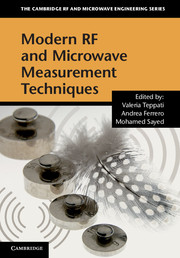Book contents
- Frontmatter
- Contents
- Preface
- List of contributors
- List of abbreviations
- Part I General concepts
- Part II Microwave instrumentation
- Part III Linear measurements
- Part IV Nonlinear measurements
- 12 Vector network analysis for nonlinear systems
- 13 Load- and source-pull techniques
- 14 Broadband large-signal measurements for linearity optimization
- 15 Pulse and RF measurement
- Index
- References
15 - Pulse and RF measurement
from Part IV - Nonlinear measurements
Published online by Cambridge University Press: 05 June 2013
- Frontmatter
- Contents
- Preface
- List of contributors
- List of abbreviations
- Part I General concepts
- Part II Microwave instrumentation
- Part III Linear measurements
- Part IV Nonlinear measurements
- 12 Vector network analysis for nonlinear systems
- 13 Load- and source-pull techniques
- 14 Broadband large-signal measurements for linearity optimization
- 15 Pulse and RF measurement
- Index
- References
Summary
Introduction
Circuits exhibit a variety of operational traits that are far from the behavior presented in introductory circuit design textbooks. Transistor characteristics curves vary significantly depending on how they are measured and on the history of electrical conditions. The characteristics are not always repeatable, which raises the dilemma of the choice of which characteristic to base a design upon.
The central idea behind pulse measurements is that the high-frequency characteristics of a device are a function of a quiescent operating condition. Pulse techniques attempt to determine these in an invariable operating condition. If short enough pulses are used, a pulse measurement at a specific condition of operation gives the characteristics that a high-frequency signal would encounter. This is a simple idea, but there is a practical limit to how short the pulses can be, so it is then necessary to draw upon radio-frequency techniques to probe past higher-frequency anomalies in the characteristics.
Dynamic processes and interactions in active elements produce seemingly complicated electrical characteristics that are best explored with pulse and RF techniques. These processes can be traced to mechanisms of self-heating by power dissipation, bias-dependent change in trapped charges, and to impact ionization and breakdown.
This chapter covers a set of topics that provide a foundation for understanding the pulse measurement technique augmented with RF measurements. Pulse characterization techniques dovetail with RF and nonlinear techniques to explore transistor dynamics for small-signal and nonlinear applications.
- Type
- Chapter
- Information
- Modern RF and Microwave Measurement Techniques , pp. 414 - 441Publisher: Cambridge University PressPrint publication year: 2013

